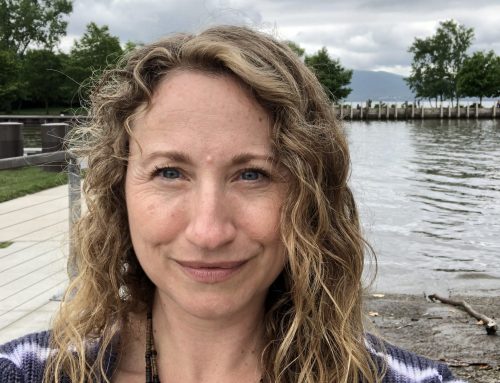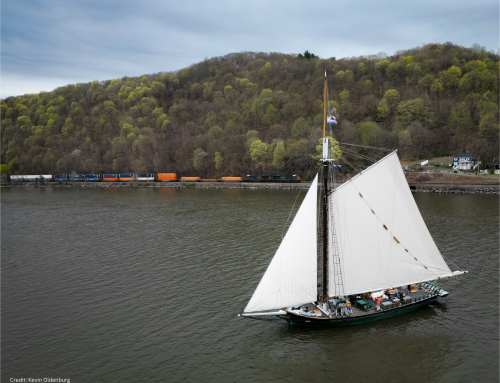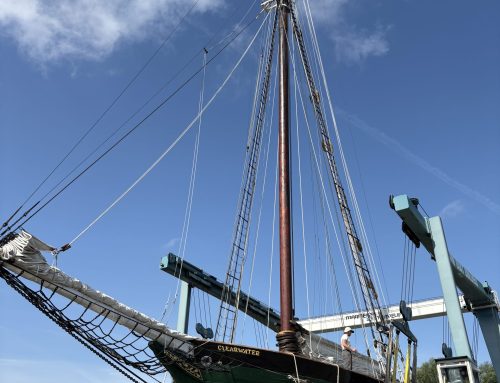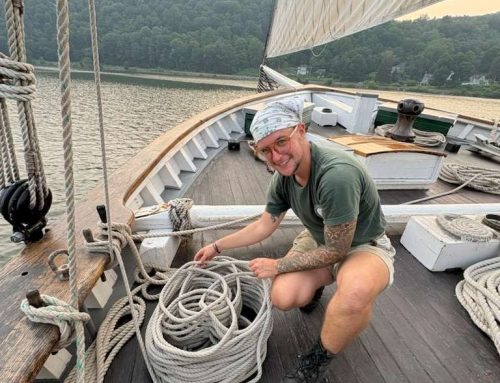Drinkable, Swimmable, Fishable: Clearwater Celebrates 50+ Years of the Clean Water Act
A Symposium on the Clean Water Act
NEWBURGH, NY – On Friday, April 14, Clearwater hosted a symposium on the Clean Water Act, to reflect upon the progress made in the 50-years since its passage, explore its limitations, and discuss opportunities and emerging threats to continued progress toward a swimmable and fishable Hudson River. Passed in 1972, the Clean Water Act established the goal of fishable and swimmable waters across the United States by 1983, as well as the elimination of pollutants into navigable waters by 1985. Though these goals have yet to be met, the CWA has resulted in significant improvements to water quality in the Hudson River and its tributaries. At the same time, new threats to the Hudson have emerged, creating new obstacles to reaching the goals of the Clean Water Act.
The program centered panels focusing on the three primary goals of the Clean Water Act – swimmable, fishable, and drinkable waters. Local experts ranging from regional advocacy organizations, to state agencies, to grassroots organizations provided insight into the progress made toward these goals over the last five decades, as well as into limitations and emerging threats. Additionally, keynote speaker John Cronin explored the history of and need for a 21st Century Clean Water Act, and Libby Zematis from the Hudson River Estuary Program spoke about current resilience efforts in the Hudson Valley. Available below is the recording of the Symposium as well as short synopses for each talk, and ways to learn more and take action. Moderator and speaker biographies are available here.
Talks and Presentation Overviews
INTRODUCTION: Manna Jo Greene, Environmental Action Director Hudson River Sloop Clearwater
View Presentation Slides
A 21ST CENTURY CLEAN WATER ACT, John Cronin, Director of Blue CoLab at Pace University
Watch the Keynote Address
View Presentation Slides
It is time for a new celebration of a new Clean Water Act. The current Act, now 50 years old, has survived waves of attacks but not achieved its primary objective — to end water pollution. Indeed, federal and state agencies have abandoned that objective completely, along with the Act’s major policy goals, now overdue by four decades. With abundant evidence that national water quality is in decline, it is time to rally around a Clean Water Act for the 21st century, and look forward to the day when we celebrate its first anniversary. Check out this clip of John Cronin in action as the Riverkeeper in the organization’s early years.
SWIMMABLE PANEL:
Moderated by Fran Dunwell, Retired Founder and Former Coordinator of the Hudson River Estuary Program, New York State Department of Environmental Conservation
Watch the Swimmable Panel
SWIMMABLE PANEL INTRODUCTION: Fran Dunwell, Panel Moderator
The river of my childhood was very polluted, and rampant dumping of toxic chemicals, dyes, paints, heavy metals, butcher waste and sewage. After the Clean Water Act (CWA) many sewage treatment plants were built and the few existing ones were upgraded, but there was little to no effective enforcement. The Clearwater People’s Pipewatch project started to change that, and I learned about it when I attended a sloop festival in Poughkeepsie. This event inspired me to begin what became an almost 50 career of river conservation, starting in 1975. In that time, I’ve learned lessons that we will discuss today. They are:
- The importance of money. Clean up of the Hudson as we experience it today would not have been possible without funding from multiple NYS Bond Acts, appropriations to the NYS Environmental Protection Fund, and federal infrastructure programs. After the initial CWA investments, there was a long period of time with state or federal funding for clean water. That changed in 2008 with new investments from a variety of sources and increased again recently with massive new state and federal funding levels—about $1 billion last year alone.
- The importance of setting time bound goals. In 2003 DEC’s Estuary Program set a goal of making the river swimmable by 2009, and that forced the clean-up of the combined sewer overflows in the capital region around Albany. Goals need to be relevant to what people care about.
- The importance of non-governmental organizations, coalition building and bi-partisan political leadership. The Clean Water Coalition of environmental and labor groups created the public support necessary for political leaders to pass budgets that supported the clean-up of the Hudson.
Fran Dunwell was a major contributor to the recently released Hudson River Estuary Action Agenda, a conservation and restoration blueprint that guides the work of the Estuary Program and its partners. The Action Agenda expresses a shared vision for the region, as defined by diverse groups of people who live and work along the river and in its valley. The Estuary Program’s role is to develop the essential actions necessary to achieve that vision and to organize, support, and guide our many partners to realize the goals of the vision. The 2020 State of the Hudson Report was also referenced during Fran’s remarks and is a valuable point of reference.
HUDSON RIVER ACCESS: Jeffrey Anzevino, AICP, Director of Land Use Advocacy, Scenic Hudson
View Presentation Slides
We once turned our backs on the Hudson River. Now, thanks to the Clean Water Act it’s a magnet. More and more people want to walk along it, launch a boat in it, and even swim in it. But our work is not done. It’s more important than ever to continue to make progress by upgrading water treatment plants to stop combined sewer overflows, control non-point pollution and clean up industrial pollution such as PCBs.
- What you can do:
- Celebrate our mutual successes and enjoy our Hudson River
- Participate in local planning processes
- Ensure your community has a Local Waterfront Revitalization Program
- Keep apprised of Scenic Hudson’s river access initiatives and take action
WATER QUALITY: Dan Shapley, Senior Director of Advocacy, Riverkeeper
View Presentation Slides
The Hudson River and waters around New York City host more than 25 open water swim events annually, with 5,500 swimmers taking part annually — and yet the Hudson has just four public beaches or river pools, and many formal and informal access sites are vulnerable to sea-level rise. Water quality in the Hudson River estuary is safe for swimming in most locations tested, most of the time, and yet many areas are still risky after rain, particularly near the 650+ combined sewer overflows (CSOs) that discharge untreated sewage after rain into the Hudson River, Mohawk River, and other waters around New York City. Communities have invested, with federal and state support, hundreds of millions of dollars to improve wastewater infrastructure since state investments ramped up in 2017, and yet communities still need more than $2.2 billion to address aging and inadequate pipes. Extreme storms will make it more challenging to maintain and improve water quality.
- Support Riverkeeper’s priorities to:
- Stop CSOs, Fix Our Pipes & Manage Our Watersheds! Support state/federal investments to meet $2.2 billion+ need
- Make our River Swimmable! Upgrade Water Quality Standards
- Make River Swimming Accessible! Build new pools and beaches
- Focus on Water Quality & Access in Adaptation Planning. Plan for extreme storms & sea-level rise
- Take Action to protect the Hudson River
HARMFUL ALGAE BLOOMS (HABs): Emily Vail, Executive Director, Hudson River Watershed Alliance
View presentation slides
As climate change impacts the Hudson River watershed, we are faced with new and increased water quality challenges. Harmful Algal Blooms form green slicks on lakes, ponds, and even rivers and streams, and these specific cyanobacteria can create toxins that are harmful for people and animals. Blooms can form when waterbodies have warm temperatures, slow flowing water, and high levels of nutrients, and observations have been increasing in recent years. Harmful Algal Blooms are challenging to predict, manage, and, with conditions that may change day to day or hour to hour, communicate about to the public.
- Identifying + Documenting Harmful Algal Blooms
- Stay out of discolored water – may be a health risk to people, pets, livestock
- Report potential HABs to NYS DEC
- May-October through the New York Harmful Algal Bloom System (NYHABS)
- Waterway Management
- Especially in a changing climate, consider nutrients, temperature, & flow conditions in managing waterbodies
- Monitoring, planning, implementation
- Support your local watershed group
-
- Value of watershed-scale organizing
- Need for strong foundation of cross-municipal coordination
- Scientific collaboration
- Stewarding the water
-
FISHABLE PANEL:
Moderated by David Toman, Executive Director, Hudson River Sloop Clearwater
Watch the Fishable Panel
FISHABLE PANEL INTRODUCTION: David Toman, Moderator of the Fishable Panel
The CWA established a lofty goal of “fishable” waters by 1983 establishing a goal to achieve a level of water quality suitable “for the protection and propagation of fish, shellfish, and wildlife.” Although the goal of safely fishable waters was included in the Clean Water Act, the basis of the goal was for healthy fish populations, not for fish to be suitable for eating. After the passage of the Clean Water Act, despite considerable reductions to pollution over the decades, populations of many Hudson River fish continued to decline with fisheries closing over the years. The shad fishery for example closed to both recreational and commercial fishing in 2010. As much as the fishery closure was an indicator of dwindling populations, it also created the opportunity for recovery. Management plans such as NYSDEC’s recently released Recovery Plan for Hudson River American Shad, are glimmers of hope for future robust populations and for a fishable Hudson River. Like with the other goals of the Clean Water Act, the goal of fishable waters is a lofty one we will continue to strive for over the next 50-years.
HUDSON RIVER PCBs CONTAMINATION: Althea Mullarkey, PCB Project Manager, Scenic Hudson
View Presentation Slides
The landmark Clean Water Act was established in 1972 by the US Federal Government, setting a broad vision and framework for preventing AND restoring the physical, chemical, and biological integrity of the nation’s waters. Recognizing this responsibility should be shared by the very polluters that poisoned the waterways, Congress established the Comprehensive Environmental Response, Compensation and Liability Act (CERCLA) aka :Superfund” to help the USEPA build a special fund to help the agency clean up legacy polluted sites like the Hudson River Superfund Site.
- Envision a better future for the Hudson River: Learn more about the on-going cleanup of toxic PCBs from the Hudson River
HUDSON RIVER PCBS FISH CONSUMPTION HEALTH ADVISORY: Gena Gallinger, MS, Director of Outreach and Education for New York State Department of Health’s Center for Environmental Health
View presentation slides
Even after 50 years of Clean Water Act progress, adverse impacts to water quality, human health, and wildlife remain. It’s rewarding as a risk communicator to inform people’s beliefs about environmental health risks, help people make better choices for themselves and their families, and to support actions that help address today’s environmental challenges and protect public health.
- Hudson River Fish Consumption Health Advisory Resources
- Hudson River Fish Advisory Signs – Free for landowners
- View the list of public access location where the Hudson River Fish Advisory Outreach Project is partnering with municipalities on educational signage
- Access free print materials
HUDSON RIVER FISH POPULATIONS: Stephen Stanne, Hudson River Sloop Clearwater Board of Directors and Retired NYSDEC
View presentation slides
European settlers’ early accounts of the Hudson’s fishes describe an abundant and diverse fauna. While later pollution had serious impacts, particularly in the Albany Pool, the river’s array of fish species survived and returned to that area as the Clean Water Act promoted improvements in water quality. The list of fishes found in the Hudson system, from New York Harbor up into tributaries in its watershed, currently totals 237 species. In addition to protecting water quality, the CWA’s Section 404 regulation of dredging and landfilling protects habitat; its permitting requirements set in motion the environmental assessment process that led to Westway’s demise and preservation of critical juvenile striped bass habitat off Manhattan. Modern fisheries management must account for parameters not addressed by the CWA. Problems such as overfishing of American shad and mortality of striped bass in recreational fisheries require coordinated management by multiple states visited by these fish during their ocean migrations. Climate change is impacting species that require cool water. A large proportion of the Hudson’s fishes, particularly in freshwater, are non-natives, and the recent arrival of the round goby via New York’s canal system underlines concern about invasive species. Continued funding for monitoring is essential to maintaining the abundance and diversity of the river’s fish stocks.
- Take Action – Ask Governor Hochul to take action to stop invasive species from entering the Hudson River through the Erie Canal!
- New York State Department of Environmental Conservation: Hudson and Delaware Marine Fisheries
DRINKABLE PANEL:
Moderated by Aaron Mair, Hudson River Sloop Clearwater Board of Directors
Watch the Drinkable Panel
EMERGING CONTAMINANTS: Rob Hayes, Director of Clean Water at Environmental Advocates NY
View Presentation Slides
Emerging contaminants like toxic PFAS are one of the greatest threats to New York’s drinking water. Though the state has made strides requiring the testing and treatment of “forever chemicals” in drinking water, there are currently no statewide mandates for SPDES permittees or wastewater treatment plants to test their discharges for emerging contaminants or prevent such threats to public health from entering New York’s lakes and rivers. Stopping the flow of PFAS and other emerging contaminants into our water and environment will be critical to ensuring that New York meets the Clean Water Act’s goal of drinkable, swimmable, and fishable water for all.
- Next Steps to Address PFAS in Water
- Establish stronger PFAS drinking water standards, building on US EPA’s proposal
- Stop the discharge of PFAS into our lakes, rivers, and groundwater
- March 2023: NYS DEC finalizes Guidance Values for PFOA, PFOS, and 1,4-dioxane
- PFAS Discharge Disclosure Act (S.227-A/A.3296)
- Learn more about emerging contaminants in drinking water
CITY OF NEWBURGH PERFLUOROOCTANE SULFONIC ACID (PFOS) DRINKING WATER CONTAMINATION CASE STUDY: Jennifer Rawlison, Newburgh Clean Water Project
View Presentation Slides
Jennifer’s presentation highlights the personal experience and response to the City of Newburgh’s PFAS contamination. Reflections on impacts to her family, the community and the health, the rise of the grassroots group Newburgh Clean Water Project and continuing the hope and energy to demand complete remediation of all affected areas, continued health support and monitoring of residents and developing protections to ensure a safe and heathier future for all.
- Learn more about Newburgh’s drinking source water contamination, and how to support Newburgh Clean Water Project
- Learn more about the Restoration Advisory Board
- View past Stewart Air National Guard Base Restoration Advisory Board Meetings
HUDSON 7: PROTECTING THE HUDSON RIVER AS A DRINKING WATER SOURCE: Gary Bassett, Mayor of the Village of Rhinebeck and Chair of the Hudson 7
View Presentation Slides
The Hudson River Drinking Water Intermunicipal Council commonly known as the Hudson 7 is a collaboration of seven mid-Hudson municipalities that draw drinking water from the Hudson River. They include the Town of Esopus, Town of Hyde Park, Town of Lloyd, Town and City of Poughkeepsie, Town and Village of Rhinebeck. The Hudson 7 formed nearly five years ago, on May 31st, 2018, to join forces to protect our collective drinking water supply that serves over 100,000 people in Ulster and Dutchess counties through planning, advocacy and action. The Hudson River being our primary drinking water source creates a unique challenge. The river has contaminated sediments, and receives discharges of treated sewage. It is an active transportation route, including for hazardous substances. One of our goals is to identify the portion of the Hudson River Watershed that most directly contributes to our drinking water supply with a technical assistance grant from the state known as the Drinking Water Source Protection Program (DWSP2). With the support of Riverkeeper, the Hudson 7 communities applied and all seven were selected for the NYS Drinking Water Source Protection Program (“DWSP2”), a locally led, state-supported program that empowers municipalities to take action to improve and protect their public water sources and surrounding environment.
- Learn more about the Hudson River Drinking Water Intermunicipal Council
- Attend an upcoming Hudson 7 meeting
RESILIENCE SPEAKER + CONCLUSION:
Watch Resilience + Conclusion
RESILIENCE: Libby Zemaitis, Climate Resilience Program Coordinator, NYS DEC Hudson River Estuary Program
View Presentation Slides





